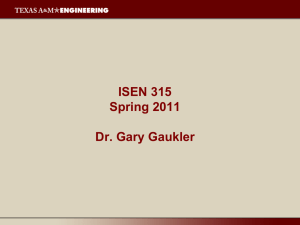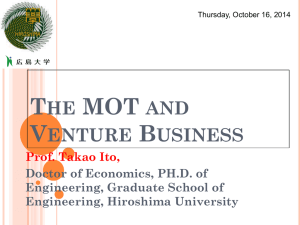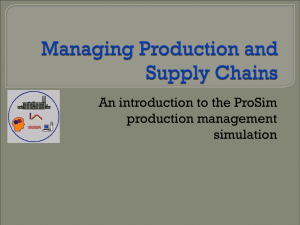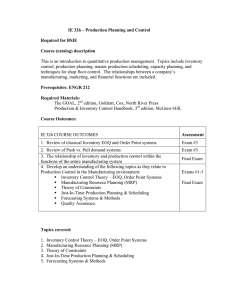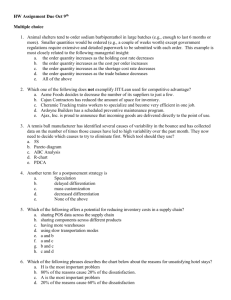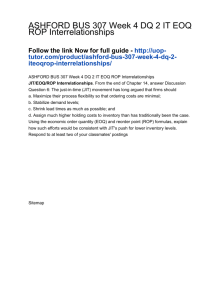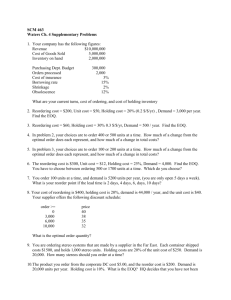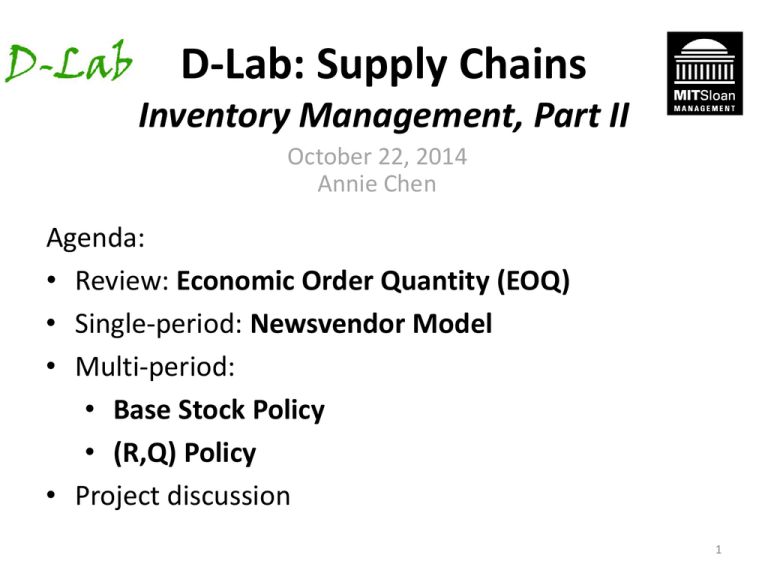
D-Lab: Supply Chains
Inventory Management, Part II
October 22, 2014
Annie Chen
Agenda:
• Review: Economic Order Quantity (EOQ)
• Single-period: Newsvendor Model
• Multi-period:
• Base Stock Policy
• (R,Q) Policy
• Project discussion
1
A talk of possible interest…
Operations Management
Seminar
Data-driven Operations Research Analyses
in the Humanitarian Sector
Abstract:
We briefly discuss six projects in the
humanitarian sector:
(1) allocating food aid for undernutrutioned
children using data from a randomized
trial in sub-Saharan Africa,
(2) allocating food aid for undernutritioned
children using data from a nutrition
project in Guatemala,
(3) analyzing the nutrition-disease nexus in
the case of malaria,
(4) allocating aid for health interventions to
minimize childhood mortality,
Lawrence Wein
(5) assessing the impact of U.S.'s failure to
Jeffrey S. Skoll Professor of
use local and regional food procurement
Management Science,
on childhood mortality, and
Graduate School of Business,
(6) deriving individualized biometric
Stanford University
identification for India's universal
© Stanford Graduate School of Business. All rights reserved. This
identification program.
content is excluded from our Creative Commons license. For
more information, see http://ocw.mit.edu/help/faq-fair-use/.
2
Types of inventory models
•
•
•
•
•
•
Demand: constant, deterministic, stochastic
Lead times: “0”,
0 , “>0”, stochastic
Horizon:: single period, finite, infinite
Products:: one product, multiple products
Capacity:: order/inventory limits, no limits
Service:: meet all demand, shortages allowed
EOQ
EOQ
Newsvendor
Base Stock
(R,Q)
Summary
Discussion
3
Types of inventory models
•
•
•
•
•
•
Demand: constant, deterministic, stochastic
Lead times: “0”,
0 , “>0”, stochastic
Horizon:: single period, finite, infinite
Products:: one product, multiple products
Capacity:: order/inventory limits, no limits
Service:: meet all demand, shortages allowed
EOQ
EOQ
Newsvendor
Newsvendor
Base Stock
(R,Q)
Summary
Discussion
4
Newsvendor Model
• Single order opportunity
• Stochastic demand
• Tradeoff: Order too little:
lost sales
Order too much:
wasted investment
• Applications: newsvendors, fashion, seasonal
retail, events, flu prevention, etc
EOQ
Newsvendor
Base Stock
(R,Q)
Summary
Discussion
5
Example: Vaccine Clinic
In preparation for a one-day
flu shot clinic, you need to
decide the quantity of
vaccines to order in
advance.
You are given a probabilistic
forecast based on historical
demand data.
Exercise: What is the expected
demand?
Sol.
EOQ
Newsvendor
Base Stock
(R,Q)
Summary
Discussion
6
Example: Vaccine Clinic
Optimal order quantity depends on the forecast and the costs:
Expected cost f(Q) = co E[overage(Q)] + cu E[underage(Q)]
What is the overage cost co and underage cost cu in the following cases?
1. Suppose vaccines costs you c = $1 per unit if ordered in advance. For every
flu shot you give, you are paid r = $5. At the end of the day, leftover
vaccines have to be thrown away, so the salvage value is v = $0.
co = c-v = 1; cu = r-c = 4 (value of lost sales)
2. Suppose c = $1, r = $5, but you can sell back leftover vaccines to a recycler
for v = $0.5 each.
co = c-v = 0.5; cu = 4
3. Suppose again c = $1, r = $5, v = $0. In addition, suppose you cannot turn
people away if you run out of pre-ordered vaccines; instead, you can make
emergency orders at double the cost, $2.
co = 1; cu = 2-1 = 1
EOQ
Newsvendor
Base Stock
(R,Q)
Summary
Discussion
7
Optimal Order Quantity
Expected cost f(Q) = co E[overage(Q)] + cu E[underage(Q)]
How do you compute the optimal order quantity?
• Sol 1: Brute-force enumeration
– Calculate f(Q) for all possible Q)
– See Excel demo
– May be cumbersome if there are lots of possible Q
• Sol 2: Take derivative of f(Q)
– See standard inventory textbooks; a bit tedious
• Sol 3: Incremental Analysis
EOQ
Newsvendor
Base Stock
(R,Q)
Summary
Discussion
8
Optimal Order Quantity
• Incremental analysis:
– What is the cost/benefit of ordering one additional unit (Q Q+1)?
1.
2.
Benefit: if the additional unit is used up, you make an extra cu. This event
happens with probability P(D>Q).
=> Expected benefit: P(D>Q) cu
Cost: if the additional unit is not used up, you wasted an investment of co.
This event happens with probability P(D≤Q).
=> Expected cost: P(D≤Q) co
– If the expected benefit outweighs the expected cost, you’d want to
continue increasing the order quantity Q. Conversely, if cost outweighs
benefit, you’d want to continue decreasing Q.
– At the optimal Q, the benefit and cost balance each other:
P(D>Q) cu = P(D≤Q) co
– Collecting the terms, we obtain the optimality condition:
Critical ratio
EOQ
Newsvendor
Base Stock
(R,Q)
Summary
Discussion
9
Example: Vaccine Clinic
Optimal order quantity depends on the forecast and the costs:
Expected cost f(Q) = co E[overage(Q)] + cu E[underage(Q)]
What is the critical ratio in the following cases?
1. Suppose vaccines costs you c = $1 per unit if ordered in advance. For every
flu shot you give, you are paid r = $5. At the end of the day, leftover
vaccines have to be thrown away, so the salvage value is v = $0.
co = c-v = 1; cu = r-c = 4 (value of lost sales)
2. Suppose c = $1, r = $5, but you can sell back leftover vaccines to a recycler
for v = $0.5 each.
co = c-v = 0.5; cu = 4
3. Suppose again c = $1, r = $5, v = $0. In addition, suppose you cannot turn
people away if you run out of pre-ordered vaccines; instead, you can make
emergency orders at double the cost, $2.
co = 1; cu = 2-1 = 1
Note: In this example, since we have a discrete probability, there is no Q that exactly
matches the optimality condition; we need to check the two options that bound it.
10
EOQ
Newsvendor
Base Stock
(R,Q)
Summary
10
(This is much
more efficient
than having to check
all possible
options forDiscussion
Q!)
Types of inventory models
•
•
•
•
•
•
Demand: constant, deterministic, stochastic
Lead times: “0”,
0 , “>0”, stochastic
Horizon:: single period, finite, infinite
Products:: one product, multiple products
Capacity:: order/inventory limits, no limits
Service:: meet all demand, shortages allowed
EOQ
EOQ
EOQ
EOQ
Newsvendor
Newsvendor
Newsvendor
Newsvendor
Base
Base Stock
Stock
(R,Q)
(R,Q)
Continuous review: (R,Q)
Periodic review: (T,S)
Summary
Summary
Discussion
Discussion
11
Multi-Period & Stochastic Demand
• Overage is no longer a big deal
– Leftover inventory can be used in the following
periods (unlike that in the single-period case)
– Cost of overage is holding cost
– Possible economies of scale for fixed ordering cost
• Underage is more serious
– Performance measure: service level
Service Level α = Prob( no stock-out )
– Need to hold safety stock to achieve service level
EOQ
Newsvendor
Base Stock
(R,Q)
Summary
Discussion
12
Service Level
• What is the stockout probability and
service level if you
ordered 2100?
• How much should
you order to
achieve a service
level of 90%? 95%?
EOQ
Newsvendor
Base Stock
(R,Q)
Summary
Discussion
13
Example: Vaccine Clinic
Suppose you are now managing a daily, non-seasonal vaccine clinic.
EOQ
Newsvendor
Base Stock
(R,Q)
Summary
Discussion
14
Ordering for Multiple Periods
• Due to economies of scale (e.g. fixed cost per order, as
in EOQ), it may be desirable to place one order to cover
multiple periods
=> need to know the distribution of demand over
multiple periods
• The Central Limit Theorem provides an approximation:
Let DT = demand over T days, where the daily demand has
mean μD and std σD
Then by the Central Limit Theorem,
DT → Normal( μ, σ2 )
where μ = TμD
σ = √TσD (as a result of summing the variance: σ2 = TσD2)
EOQ
Newsvendor
Base Stock
(R,Q)
Summary
Discussion
15
Example: Vaccine Clinic
If you reorder every T=5 days:
Aggregate demand: DT ≈ N(μT , σT2)
μT = 5 * 21.3 = 106.5
σT = √5 * 0.9 = 2.01
μ = 21.3, σ = 0.9
EOQ
Newsvendor
Base Stock
(R,Q)
Summary
Discussion
16
Service Level for Normal Distribution
N(μ,σ2)
μ
+zσ
Safety stock
Safety factor z
Service level α
In Excel: z = NORMSINV(α)
17
Tradeoff: Service Level vs. Safety Stock
Relationship is nonlinear when the service level is close to 1; i.e., need
disproportionately high safety stock to achieve very high service level
EOQ
Newsvendor
Base Stock
(R,Q)
Summary
Discussion
18
Example: Vaccine Clinic
If you reorder every T=5 days:
Aggregate demand: DT ≈ N(μT , σT2)
μT = 5 * 21.3 = 106.5
σT = √5 * 0.9 = 2.01
Service level α = 97.7% (safety factor z = 2)
Base stock level S = 106.5+4.02 = 110.5
EOQ
Newsvendor
Base Stock
(R,Q)
μ = 21.3, σ = 0.9
Summary
Discussion
19
Base Stock Policy
1. Determine review period T
– EOQ:
2. Find aggregate demand over T
– Use daily demand data & approximate with
Central Limit Theorem => N(μT , σT)
3. Find safety factor z
– Given service level α, z = NORMSINV(α)
4. Compute base stock level S = μT + z σT
EOQ
Newsvendor
Base Stock
(R,Q)
Summary
Discussion
20
Base Stock Policy with Lead Time
1. Determine review period T
– EOQ:
2. Find aggregate demand over T+L
– Use daily demand data & approximate with
Central Limit Theorem => N(μT+L , σT+L)
3. Find safety factor z
– Given service level α, z = NORMSINV(α)
4. Compute base stock level S = μT+L + z σT+L
EOQ
Newsvendor
Base Stock
(R,Q)
Summary
Discussion
21
Periodic vs. Continuous Review
• Period review:
Base stock policy
• At each review period T,
order up to base stock
level S
•
EOQ
Newsvendor
Base Stock
• Continuous Review:
(R,Q) policy
• When inventory dropps
below reorder point R,
place new order with
order quantity Q
•
(R,Q)
Summary
Discussion
22
Summary: Inventory Models
Model
EOQ
Decision
variable
Newsvendor
Base Stock
(R,Q)
•Order quantity •Order quantity
Q
Q
•(Order period T)
•Review period
T
•Order-up-to
level S
•Reorder point R
•Order quantity
Q
Demand
Constant
Stochastic
Stochastic
Stochastic
Lead time
0
0
L>0
L>0
Horizon
Infinite
Single
Infinite
Infinite (con(periodic review) tinuous review)
Optimal
solution
EOQ
Newsvendor
Base Stock
(R,Q)
Summary
Discussion
23
Project discussion
Things to consider:
• What is the inventory?
– Could be raw material, finished goods, workforce, etc.
– E.g., oxygen, manure/flies, recyclable material/fleet of
collectors, charcoal…
• What is the setup? Which inventory model might
be appropriate for this setup?
– Demand pattern: Constant or stochastic?
– Order policy: One-shot or multi-period?
• What demand data is available?
– If not available, what data should be collected?
EOQ
Newsvendor
Base Stock
(R,Q)
Summary
Discussion
24
MIT OpenCourseWare
http://ocw.mit.edu
15.772J / EC.733J D-Lab: Supply Chains
Fall 2014
For information about citing these materials or our Terms of Use, visit: http://ocw.mit.edu/terms.

